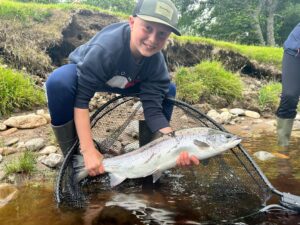Collaborative efforts between the Spey Catchment Initiative, Jahama Highland Estate, and the Spey Fishery Board lead to a vital habitat restoration project.
The Upper Spey River Restoration Project, an essential initiative aimed at enhancing the river’s habitat and supporting the recovery of dwindling wild Atlantic salmon populations, has reached completion. The Spey Catchment Initiative (SCI), Jahama Highland Estate (JHE), and the Spey Fishery Board collaborated on this project, installing Large Woody Structures (LWS) in the headwaters of the River Spey.
The success of the project comes at a critical time for Atlantic salmon, with populations at a crisis point. In 2022, SCI secured funding from NatureScot through the Nature Restoration Fund, which enabled them to use nature-based solutions to improve the habitat quality in the upper Spey River.
Before the project, the upland reaches of the River Spey lacked the complexity of habitats required to support diverse aquatic life, including juvenile salmon. This was partly due to the long-term absence of woodland on the riverbanks, resulting in few features like deeper pools, riffles, and gravel deposits.
To address this issue, sixty-five trees with their root plates attached were sourced from the Glenshero Estate and strategically installed in the river. These LWS will create more complex and varied physical habitats, offering additional microhabitats for invertebrate and microbial life. Over time, the LWS may help reconnect the river with its flood plain, reducing flood risk downstream.
Early observations show that the LWS are significantly impacting river processes, with deeper pools forming upstream of the structures and gravel bars and riffles being created below. The project will result in new and improved habitats, helping biodiversity to flourish. In the coming years, more wildlife, including the precious Atlantic salmon, will return to this section of the river.
The Upper Spey River Restoration Project also has wider benefits, such as providing natural flood management and boosting climate resilience. By slowing the flow of water out of the catchment and creating cooler refuge areas, the project helps aquatic life escape rising water temperatures and avoid being washed out during more frequent floods.
The project was delivered in partnership with the landowner, Jahama Highland Estates, and the Spey Fishery Board, with SCI’s 12 partner organizations providing additional expertise and input when needed. JHE supplied the trees and ongoing practical assistance from estate staff on the ground.
Penny Lawson, Spey Catchment Initiative Project Officer, praised the collaboration, saying, “The Upper Spey River Restoration Project is a great example of what can be achieved when the objectives of a landowner, funders, and other partners align.” Jonathan Hart, OBE, Liaison Manager for Jahama Highland Estates, echoed Lawson’s sentiment, expressing pride in the project’s success and the positive impact it has already had on the river’s ecosystem.
The completion of the Glenshero River Restoration Project marks a significant milestone in improving the ecological health of the upper Spey. With its numerous benefits, this project sets an example for other regions looking to restore their rivers and protect their biodiversity.
For further information, please visit www.speycatchment.org






